

|
| DEUTSCHLAND | GERMANY |
| Bundesland: Freistaat Bayern | Bavaria |
| Regierungsbezirk: Schwaben | |
| Stadt: Augsburg |
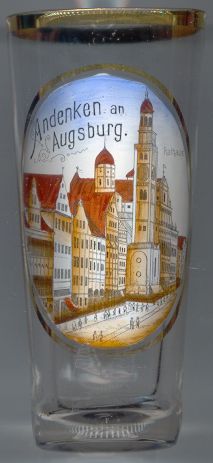 Augsburg, the capital of the region Schwaben in the German state of Bavaria, is situated at an elevation of 490 m on the river Lech.
The town (Augusta Vindelicum) was founded by the roman emperor Augustus in 15 BC as a military post at the crossroads of
important trading routes and became a roman provincial acpital for about 400 years. About 400 AD the roman rule ended and Alemannic tribes
settled in the region. In 739, Augsburg became the seat of a bishop.
In 955, Bishop (Saint) Ulrich of Augburg and Emperor Otto I (the Great) defeated the Hungarians in the famous Battle at the Lechfeld.
Emperor Friedrich I Barbarossa granted Augsburg the status of a town in 1156; the first documented version of the town rights date from 1276.
During the 15th and 16th century, Augsburg prospered as one of the wealthiest trading towns in South Germany. The wealthiest families were the
Fugger and Welser. The 'Fuggerei', the world's oldest charitable housing comlpex, was founded by Jakob Fugger (1459–1525)
in 1516. The Confessio Augustana (Augsburger Bekenntnis) was delivered to Emperor Karl V by the Protestant reformer Philipp Melanchthon
at the Diet of Augsburg in 1530, but the emperor ruled that all innovations were to be abolished. The city, however, decided to recall the Protestant
preachers and suppressed all Catholic services. In 1537, the Catholic bishops were forced to leave the city and moved the
residence of the prince-bishopric to Dillingen.
The times of religious clashes were ended by the 'Religious Peace of Augsburg' (Augsburger Religionsfriede)
at the Diet of Augsburg in 1555. The status of a Free Imperial Town that Augsburg had obtained in 1276 ended in 1806 when Augsburg became part of the
Kingdom of Bavaria.
The water management system of Augsburg that had evolved in successive phases from the 14th century to the present day was inscribed in the UNESCO
list of World Cutural Heritage Sites in 2019 (see list of other such places depicted on glasses of this collection).
Augsburg, the capital of the region Schwaben in the German state of Bavaria, is situated at an elevation of 490 m on the river Lech.
The town (Augusta Vindelicum) was founded by the roman emperor Augustus in 15 BC as a military post at the crossroads of
important trading routes and became a roman provincial acpital for about 400 years. About 400 AD the roman rule ended and Alemannic tribes
settled in the region. In 739, Augsburg became the seat of a bishop.
In 955, Bishop (Saint) Ulrich of Augburg and Emperor Otto I (the Great) defeated the Hungarians in the famous Battle at the Lechfeld.
Emperor Friedrich I Barbarossa granted Augsburg the status of a town in 1156; the first documented version of the town rights date from 1276.
During the 15th and 16th century, Augsburg prospered as one of the wealthiest trading towns in South Germany. The wealthiest families were the
Fugger and Welser. The 'Fuggerei', the world's oldest charitable housing comlpex, was founded by Jakob Fugger (1459–1525)
in 1516. The Confessio Augustana (Augsburger Bekenntnis) was delivered to Emperor Karl V by the Protestant reformer Philipp Melanchthon
at the Diet of Augsburg in 1530, but the emperor ruled that all innovations were to be abolished. The city, however, decided to recall the Protestant
preachers and suppressed all Catholic services. In 1537, the Catholic bishops were forced to leave the city and moved the
residence of the prince-bishopric to Dillingen.
The times of religious clashes were ended by the 'Religious Peace of Augsburg' (Augsburger Religionsfriede)
at the Diet of Augsburg in 1555. The status of a Free Imperial Town that Augsburg had obtained in 1276 ended in 1806 when Augsburg became part of the
Kingdom of Bavaria.
The water management system of Augsburg that had evolved in successive phases from the 14th century to the present day was inscribed in the UNESCO
list of World Cutural Heritage Sites in 2019 (see list of other such places depicted on glasses of this collection).
The  Town Hall (Rathaus) [right, no. 1483: background right] was built between 1615 and 1620 by the architect Elias Holl.
It is one of the most important examples of Renaissance architecture in Germany. During World War II the town hall was completely
destroyed during a bomb raid in 1944. After the war the façade was rebuilt. A thorough restoration with reconstructions of
parts of the historic rooms followed in 1985.
Town Hall (Rathaus) [right, no. 1483: background right] was built between 1615 and 1620 by the architect Elias Holl.
It is one of the most important examples of Renaissance architecture in Germany. During World War II the town hall was completely
destroyed during a bomb raid in 1944. After the war the façade was rebuilt. A thorough restoration with reconstructions of
parts of the historic rooms followed in 1985.
The  Perlachturm [right, no. 1483: foreground right] next to the town hall
is part of the monastery church St. Peter am Perlach. The tower was built in 1182 on a substructure of an earlier tower of the 11th/12th century.
The belfry and roof were added by Elias Holl in 1614. Some modifications were made during the 18th century. The tower has a height of 70.4 m
and offers a splendid view over the city of Augsburg.
Perlachturm [right, no. 1483: foreground right] next to the town hall
is part of the monastery church St. Peter am Perlach. The tower was built in 1182 on a substructure of an earlier tower of the 11th/12th century.
The belfry and roof were added by Elias Holl in 1614. Some modifications were made during the 18th century. The tower has a height of 70.4 m
and offers a splendid view over the city of Augsburg.
St. Ulrich (890–973 AD) became bishop of Augsburg in 923 and defended Augsburg against the Hungarians in 955 together with Otto the Great.
He was canonized as a saint of the Catholic church in 993 by Pope Johannes XV.
(see also list of other basilicae minores depicted on glasses of this collection)
The
The top part of the picture on glass no. 1590 [right] shows the Perlachturm and the Town Hall
(see above).
The
The
Rudolf DIESEL (1858–1913) invented the internal combustion engine in Augsburg in 1892. The first working engine of 1897 today
is exhibited in the Deutsches Museum in Munich. The engine today is also known as 'Diesel engine'.
Berthold BRECHT (1898–1956), famous German playwright, was born in Augsburg.
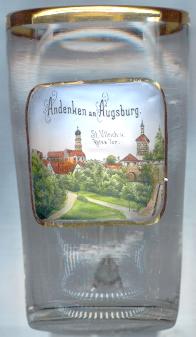
The  church Sankt Ulrich und Afra [left] was built as the church of the free Imperial Benedictine abbey in 1474. The chancel
was completed in the 16th/17th century. The tower has a height of 93 m. The interior decorations of the Late Gothic basilica date from the
Renaissance and Baroque periods. The church also contains the burial places of the patron saints of the Augsburg diocese, Ulrich, Afra and Simpert.
In 1937 the church received the papal title of a Basilica minor.
church Sankt Ulrich und Afra [left] was built as the church of the free Imperial Benedictine abbey in 1474. The chancel
was completed in the 16th/17th century. The tower has a height of 93 m. The interior decorations of the Late Gothic basilica date from the
Renaissance and Baroque periods. The church also contains the burial places of the patron saints of the Augsburg diocese, Ulrich, Afra and Simpert.
In 1937 the church received the papal title of a Basilica minor.
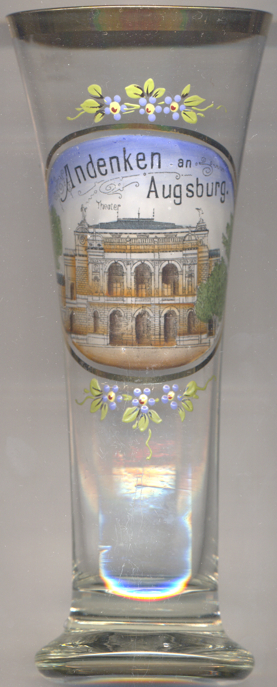
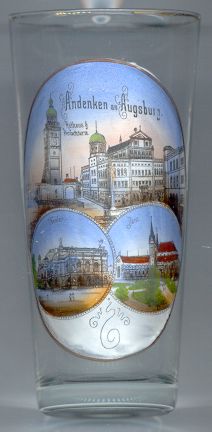 The
The  Stadttheater (Municipal Theatre) [left, no. 3161 and right, no. 1590: bottom left]
was built in 1876–1877 by the famous theatre architects Ferdinand Fellner and Hermann Helmer. It was re-opened in 1939
after extensive renovations and altreations, but was destroyed by bombs on 25/26 February 1944. A modern theatre was built in
its place in 1952–1956.
Stadttheater (Municipal Theatre) [left, no. 3161 and right, no. 1590: bottom left]
was built in 1876–1877 by the famous theatre architects Ferdinand Fellner and Hermann Helmer. It was re-opened in 1939
after extensive renovations and altreations, but was destroyed by bombs on 25/26 February 1944. A modern theatre was built in
its place in 1952–1956.
(See also list of further buildings by Fellner and Helmer
that are depicted on glasses of this collection.)
 Cathedral of Our Lady (Mariendom) [right, no. 1590: bottom right]
was founded around 700 AD. The first document mentioning the cathedral of Our lady dates from 822.
The crypt under the west choir was built in 960 by bishop Ulrich, the Romanesque west choir followed between 994 and 1065.
The two Gothic naves and the east choir were added between 1321–1341. Between 1537 and 1548, during the Reformation,
parts of the church were damaged andmany of its images and altars were destroyed. The Lady chapel was created in 1721.
The whole church was renovated in Neo-Gothic style in 1852–1863. Many of the original, Gothic, decorations
were recovered and restored by renovations works in 1934.
Cathedral of Our Lady (Mariendom) [right, no. 1590: bottom right]
was founded around 700 AD. The first document mentioning the cathedral of Our lady dates from 822.
The crypt under the west choir was built in 960 by bishop Ulrich, the Romanesque west choir followed between 994 and 1065.
The two Gothic naves and the east choir were added between 1321–1341. Between 1537 and 1548, during the Reformation,
parts of the church were damaged andmany of its images and altars were destroyed. The Lady chapel was created in 1721.
The whole church was renovated in Neo-Gothic style in 1852–1863. Many of the original, Gothic, decorations
were recovered and restored by renovations works in 1934.
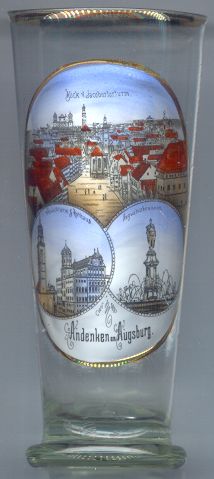
 Augustusbrunnen [left, no. 2074: bottom right picture]
in front of the Town Hall is the oldest of the three monumental fountains in Augsburg's main street, Maximilianstraße.
The Renaissance fountain was created in 1588–1594 by the Dutch sculptor Hubert Gerhard.
The bronze sculpture of the Roman emperor Augustus which crownes the fountain was cast by Peter Wagner.
The original today is exhibited in the entrance hall of the Town Hall, a copy replaces the original on the fountain.
The four figures beneath the emperor's sculpture are allegories of the four rivers that flow through Augsburg:
Lech, Wertach, Singold and Brunnenbach.
Augustusbrunnen [left, no. 2074: bottom right picture]
in front of the Town Hall is the oldest of the three monumental fountains in Augsburg's main street, Maximilianstraße.
The Renaissance fountain was created in 1588–1594 by the Dutch sculptor Hubert Gerhard.
The bronze sculpture of the Roman emperor Augustus which crownes the fountain was cast by Peter Wagner.
The original today is exhibited in the entrance hall of the Town Hall, a copy replaces the original on the fountain.
The four figures beneath the emperor's sculpture are allegories of the four rivers that flow through Augsburg:
Lech, Wertach, Singold and Brunnenbach.
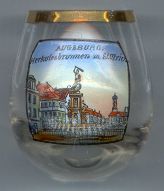
 Herkulesbrunnen [right, no. 1792]
is the largest of the three monumental fountains in Augsburg's main street, Maximilianstraße.
It was cast in 1602 by Wolfgang Neidhart according to a design made by the Dutch artist Adrian de Vries between 1597 and 1600.
The centrepiece shows the struggle between Herkules and the sevenheaded hydra. The fountain symbolises the Roman origins
of the town, the world-wide connections of the town's traders, and the abundance of water in Augsburg.
Herkulesbrunnen [right, no. 1792]
is the largest of the three monumental fountains in Augsburg's main street, Maximilianstraße.
It was cast in 1602 by Wolfgang Neidhart according to a design made by the Dutch artist Adrian de Vries between 1597 and 1600.
The centrepiece shows the struggle between Herkules and the sevenheaded hydra. The fountain symbolises the Roman origins
of the town, the world-wide connections of the town's traders, and the abundance of water in Augsburg.
Mozart's father, Leopold MOZART (1719–1787), was born in Augsburg. He studied philosophy in Salzburg
and later became a member of the court orchestra of the prince archbishop. In 1757 he was appointed composer to the court and chamber, and in 1763
beacme deputy Kapellmeister. His birth house is a museum today.
![[scale]](lineal.jpg)